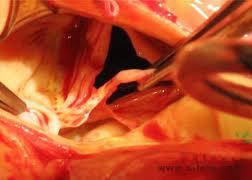最近在线发表在《美国医学会杂志》上[JAMA.2012;308(6):573-574]的一篇研究报告显示,加拿大不列颠哥伦比亚省温哥华市圣保罗医院的高级研究员JohnG Webb医师进行的单中心极早用经导管主动脉瓣置入(TAVI)装置的5年结果显示,效果持久,并且可能和很多外科瓣膜一样持久。
Webb解释说这一系列研究代表了第一代经导管瓣膜中的第一种人工置入物。这些装置于2005年1月至2007年3月间被置入重度有症状的主动脉瓣狭窄患者中。1~5年的生存率分别为83%、74%、53%、42%和35%。Webb也指出,这些数据需要放在一定的背景中进行验证。
Webb指出,在这项早期可行性研究中,TAVI操作仅向病情极重度患者(由于年龄较大和存在其他严重共病,预期5年生存差)提供。死亡率高不是因为瓣膜恶化,而是由于进入这些极早期实验评价的患者类型。
首批TAVI长期转归报告之一
Toggweiler和同事解释说,尽管TAVI(TAVR)日益受到欢迎,被称为2012年心脏病学‘最热’话题之一,但是既往报告关注的是短期和中期转归,对于较长期转归知之甚少。
该研究共有111例患者(平均年龄83岁)在圣保罗医院接受用球囊扩张Cribier-Edwards或Sapien瓣膜(Edwards生命科学公司)的TAVI治疗,所有患者均接受阿司匹林(终身)和氯吡格雷(3个月)治疗。如果有口服抗凝指征,则在患者可耐受的情况下予以华法林和双联抗血小板治疗(3个月)。
研究者们指出,上述初始111例患者在确实无法手术患者中的首次经动脉和经心尖TAVI经验,该操作的很多步骤当时并未标准化,因此围操作期间死亡率相对高。由于该论文的焦点在于评价5年转归,因此瓣膜置入不成功的患者或在30天内死亡的患者被排除出分析,最终剩下88例患者接受评价。
5年时,观察到3例患者出现中度经导管人工瓣膜功能衰竭,但没有患者发生重度经瓣膜反流或再狭窄。大多数患者伴随的二尖瓣反流改善,并且在随访5年后仍保持改善。整个观察期间,超过90%的患者为NYNA1级或2级。
5年累计严重缺血性卒中发生率为9.7%,慢性阻塞性肺疾病(校正风险比[HR]为2.17)和至少中度瓣周反流(校正HR为2.98)的患者死亡风险显著升高。
研究者们指出,该研究显示成功TAVI后5年转归良好,并且血液动力学极佳,中度人工瓣膜功能衰竭的征象仅见于3.4%的患者。
Webb评价道,以前,我们不知道这些瓣膜是否会持续5年,现在知道了。现在可以说,预期生存长于5~10年的患者有可能从持久瓣膜中获益。这代表了我们当前进行该操作的目标人群可以确定了。

'Favorable' five-year outcomes with early TAVI devices
Vancouver, BC - New data showing five-year outcomes at a single center with the very earliest transcatheter aortic valve implant (TAVI) devices indicate that they are durable and "may last as long as many surgical valves," says senior author Dr John G Webb (St Paul's Hospital, Vancouver, BC).
"This series represents the very first in man implants of first generation transcatheter valves," explains Webb. The devices were implanted in patients with severe symptomatic aortic stenosis from January 2005 to March 2007. Survival rates at one to five years were 83%, 74%, 53%, 42%, and 35%, respectively. Webb says that these figures need to be put into context, however.
During this early feasibility study, the procedure was only offered to extremely ill patients who were anticipated to have a poor five-year survival due to advanced age and other severe comorbidities. The high late mortality was not due to valve deterioration, but due to the types of patients entered into these very early experimental evaluations," he told heartwire.
The results are published in the Journal of the American College of Cardiology by Dr Stefan Toggweiler (St Paul's Hospital, Vancouver, BC) and colleagues .
One of the first reports of long-term outcomes with TAVI
Toggweiler and colleagues explain that despite the growing popularity of TAVI (TAVR)—which was named one of the 'hottest' topics in cardiology for 2012—previous reports have focused on short- and mid-term outcomes, and little is known about longer-term outcomes.
In total, 111 patients (mean age 83 years) underwent TAVI at St Paul's Hospital with the balloon-expandable Cribier-Edwards or Sapien valve (Edwards Lifesciences, Irvine, CA), and all were treated with aspirin (lifelong) and clopidogrel (for three months). If oral anticoagulation was indicated, patients were treated with warfarin and dual antiplatelet therapy (for three months), if tolerated.
The high late mortality was not due to valve deterioration, but due to the types of patients entered into these very early experimental evaluations.
These initial 111 patients represent the first in-human experience with transarterial and transapical TAVI in truly inoperable patients, and many steps of the procedure were not standardized at the time, so peri-procedural mortality was relatively high, the researchers note. Because the focus of the paper was to evaluate five-year outcomes, those with unsuccessful valve implantation or who died within 30 days were excluded from the analysis, leaving 88 patients who were assessed, they explain.
Mean aortic valve gradient decreased from 46 to 10 mmHg after TAVI, and to 11.8 mmHg after five years (p=0.06 for post-TAVI trend). Mean aortic valve area increased from 0.62 to 1.67 cm2 after TAVI, and to 1.40 cm2 at five years (p<0.01 for post-TAVI trend).
Moderate prosthetic transcatheter valve failure was observed in three patients at five years, but no patient developed severe transvalvular regurgitation or restenosis. Concomitant mitral regurgitation improved in the majority of patients and remained improved at the five-year follow-up. More than 90% of patients were in NYHA class 1 or 2 during the whole observation period, the authors say.
We did not know if these valves would last five years. We now do.
Cumulative major ischemic stroke rate at five years was 9.7%, and risk of death was significantly increased in patients with chronic obstructive pulmonary disease (adjusted hazard ratio [HR] 2.17) and at least moderate paravalvular regurgitation (adjusted HR 2.98).
"Our study demonstrated favorable outcomes five years after successful TAVI with excellent hemodynamics and signs of moderate prosthetic valve failure observed in only 3.4% of patients," the researchers state.
Webb commented to heartwire. "We can now say that patients expected to live longer than five to 10 years have the possibility of long-term benefit from a durable valve. This would represent our current target group for this procedure."
本站所注明来源为"爱爱医"的文章,版权归作者与本站共同所有,非经授权不得转载。
本站所有转载文章系出于传递更多信息之目的,且明确注明来源和作者,如果您认为我们的转载侵犯了您的权益,请及时通过电话(400-626-9910)或邮箱(zlzs@120.net)通知我们,我们将第一时间处理,感谢。





